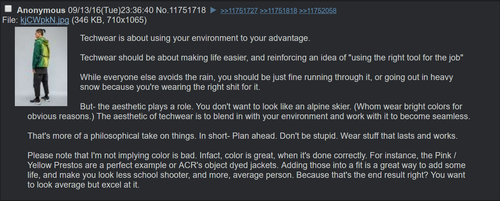Guide to Urban Techwear
We wear clothes to be comfortable, to cover up our shame, and more importantly for our protection. Technical clothing, focuses on incorporating functionality through the use of textiles and construction techniques, this is a very broad definition. When you mention clothes a wide array of different designs will come to mind and its the goes the same with technical clothing, although the fashion community likes to lump technical clothing into this one style. This idea that it's a futuristic military style, but that's just not the case. Conroy Nachtigall a former designer of Arc'teryx Veilance explains creating technical clothing as: "It's not thinking about zippers is not thinking about seem tapes, not thinking about ... all these little elements. Those are all part of the end goal"
Lets take the time to defuse what technical clothing has become into its various styles it has grown these past years. Causal Techwear, has the basic familiarity when you think of clothes: shirts, pants, socks, etc. Using advanced fabrics in such a low profile look, casual techwear can be incorporated into anything often being some of the best additions to a wardrobe for any aesthetic. Tech focused is taking one step up, putting the technology first and its design second having more functionality than casual techwear, but also very versatile when constructing a fit, often taking a simple more modern approach to its style.
Utilitarian, or the community likes to brand it "Techninja" is centered around the futuristic dystopia placed in an urban setting. Brands that center themselves around this push for an ever greater liberation in movements, incorporating various storage options, increasing ease of use, and often using the latest materials to come out of the woodworks. Do not get this confused, do not try to lump all of techwear into this mindset because its just not true. Hopefully you have an understanding of what techwear is, and appercation for all the forms it can take.
Understanding The Technical Wardrobe
Memebranes
The membrane in textiles are designed to give a layer of defense against the environment. Membranes can fall into these two categories: hydrophillic and microporous. Hydrophillic is the love for water, it allows incoming water to permeate the surface and the water below the membrane to be push outwards. Microporous lets water escape from your body, however its surface is impermeable leaving the user dry.
Shells
A shell are commonly referred to as simply as just a jacket, and people that call it this wouldn’t be wrong. At the end of this we hope you’ll appreciate the term shell over calling it a jacket. The term shell is used by companies that specialize in technical clothing as it implies a greater layer of protection from the outside. Such features a shell would come with is water resistants, wind proof, heat retention and more. Shells go into two categories, the hardshell and the softshell
The hardshell is the primary layer, often the most expensive piece to the arsenal. The hardshell provides the most function and durability out of an entire fit. The hardshell membrane would include the basics such as waterproof, wind resistant or proofed, and breathablity.
The softshell, given by its name isn’t as durable as the hard shell, however it does share many qualities. The common trade off between the softshell and a hardshell is ease of use and many functions that would come to wearing a hardshell. Still they retain such attributes likes breathability, heat retention, and protection from wind and water.
Base
Given by its name, the base layer is the absolute bottom layer in any fit. This would include the average: socks, underwear, undershirts, and shirts. In the functional clothing industry they often carry attributes that levitate around making the wearer more comfortable, such things like this include: breathability, anti-bacterial, deordorizing, heat retention, streachable etc.
Merino is the common material in this field, merino wool is wicking and a natural temperature regulator, very durable and long lasting, however buying clothes made of merino could be very expensive. Other brands, such as UNIQLO might use a blend of materials to produce layers that aid in function. Companies that practice such things tend to be much cheaper and don't provide the many functions gained by wearing a layer of merino.
